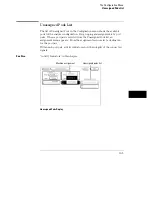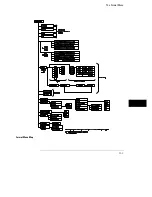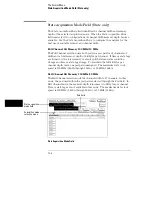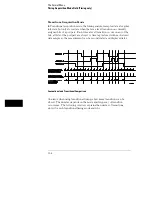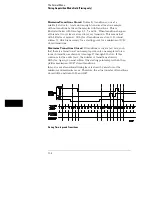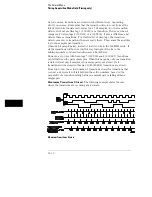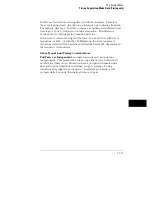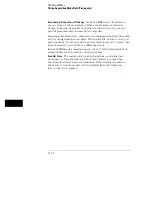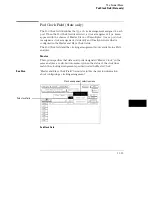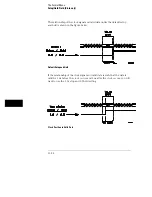
Transitional Half Channel 250 MHz Mode
The total memory depth is 8 Kbytes with a channel width of 17 channels on
one pod. The pod used within the pod pair is selectable. Data is sampled for
new transitions every 4 ns.
Transitional timing running at 250 MHz is the same as the 125 MHz mode,
except that two single pod data samples (17 bits x 2 = 34 bits) are stored
instead of one full pod pair data sample (34 bits). This is because in half
channel mode, data is multiplexed into the sequencer pipeline in two 17 bit
samples. The first 17 bit sample is latched, the next 17 bit sample is sent
down the pipeline along with the latched 17 bit sample.
This operation keeps the pipeline frequency down to 125 MHz. It should be
noted that the transition detector still looks at a full 34 bits. This means it is
looking at two samples at a time instead of one. In this mode, between 682
and 4094 transitions are stored.
Minimum Transitions Stored
The following example shows what data
is stored from a data stream with transitions that occur at a slow rate
(more than 24 ns apart).
Minimum Transitions Stored
The Format Menu
Timing Acquisition Mode Field (Timing only)
11–9
Summary of Contents for 1660A Series
Page 5: ...vi...
Page 14: ...1 Introduction...
Page 24: ...2 Probing...
Page 35: ...Probing Assembling the Probing System 2 12...
Page 36: ...3 Using the Front Panel Interface...
Page 65: ...3 30...
Page 66: ...4 Using the Mouse and the Optional Keyboard...
Page 74: ...5 Connecting a Printer...
Page 91: ...5 18...
Page 92: ...6 Disk Drive Operations...
Page 118: ...7 The RS 232C GPIB and Centronix Interface...
Page 121: ...RS 232 GPIB Menu Map Cont The RS 232C GPIB and Centronix Interface 7 4...
Page 123: ...Printer Controller Menu Map Cont The RS 232C GPIB and Centronix Interface 7 6...
Page 132: ...8 The System Utilities...
Page 137: ...9 The Common Menu Fields...
Page 150: ...9 14...
Page 151: ...10 The Configuration Menu...
Page 159: ...11 The Format Menu...
Page 161: ...Format Menu Map The Format Menu 11 3...
Page 194: ...11 36...
Page 195: ...12 The Trigger Menu...
Page 198: ...Trigger Menu Map The Trigger Menu 12 4...
Page 199: ...Trigger Menu Map Continued The Trigger Menu 12 5...
Page 235: ...13 The Listing Menu...
Page 237: ...Listing Menu Map The Listing Menu 13 3...
Page 260: ...13 26...
Page 261: ...14 The Waveform Menu...
Page 263: ...Waveform Menu Map The Waveform Menu 14 3...
Page 264: ...Waveform Menu Map cont The Waveform Menu 14 4...
Page 300: ...14 40...
Page 301: ...15 The Mixed Display Menu...
Page 306: ...15 6...
Page 307: ...16 The Chart Menu...
Page 310: ...Chart Menu Map The Chart Menu 16 4...
Page 311: ...Chart Menu Map cont The Chart Menu 16 5...
Page 336: ...16 30...
Page 337: ...17 The Compare Menu...
Page 340: ...Compare Menu Map The Compare Menu 17 4...
Page 355: ...18 Error Messages...
Page 363: ...19 Specifications and Characteristics...
Page 377: ...20 Operator s Service...
Page 386: ...Troubleshooting Flowchart 1 Operator s Service To use the flowcharts 20 10...
Page 387: ...Troubleshooting Flowchart 2 Operator s Service To use the flowcharts 20 11...



